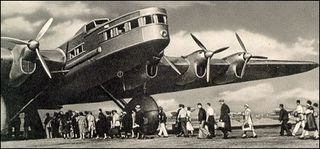NEWS TRIVIA FROM EUROPEAN PAPERS
While we were in Europe, I enjoyed reading the European newspapers. One item I thought amusing was in the London Daily Mail. It reported that billionaire socialite Goga Ashkenazi was at a charity auction when an expensive painting was being auctioned off. She made the mistake of spotting her new friend, Jennifer Lopez, at the auction. The mistake was she waived to her and that resulted in her inadvertently buying a $240,000 pound ($347,544.00 in U.S. dollars) painting by accident.
I had not heard about a Soviet gigantic airplane that the International Herald had a short item about. I  was born in 1935. This airplane was one of the largest aircraft ever to fly and was built in the 1930s. Therefore I was interested in reading about the airplane known as the "Maxim Gorky." . Stalin commissioned the passenger plane and named it in honor of the famous political writer of the time. Stalin wanted to convince the world that Russia was the leader in aviation and aviation technology. When his engineers failed to set distance or other records they might well be sent off to gulags. So, they worked hard on this aircraft that Stalin wanted to show case to the world.
was born in 1935. This airplane was one of the largest aircraft ever to fly and was built in the 1930s. Therefore I was interested in reading about the airplane known as the "Maxim Gorky." . Stalin commissioned the passenger plane and named it in honor of the famous political writer of the time. Stalin wanted to convince the world that Russia was the leader in aviation and aviation technology. When his engineers failed to set distance or other records they might well be sent off to gulags. So, they worked hard on this aircraft that Stalin wanted to show case to the world.
The construction of this gigantic airplane took place during the great famine. It was a time when some 7 to 8 million Russians were killed under Stalin. And the entire airplane factory was devoted to the construction of this aircraft. 800 workers were involved in its construction. The cost of construction was some $4. 5 million dollars. The purpose of constructing this aircraft was to serve as a propaganda tool. Work on the plane started from the late 1933 through the spring of 1934.
This was a huge airplane. It was 112 feet long 22 feet high and had a wingspan of 206 feet. The 5200 ft. surface area resulted in the airplane weighing some 59 tons. The plane’s wings were so large they were fitted with bunk beds. When it was finished it was 11 feet more than the early Boeing 747 in its wingspan. It was equipped originally with 8 engines. Three on each wing and two mounted above. Later the engines above were removed. The interior of the aircraft included printing machinery, a photographic laboratory, a theater with film projector with sound for showing movies while in flight, and a library. The aircraft was equipped with a very powerful radio called the "voice from the sky." The aircraft also had individual lounge rooms for people on board. The photo engraving plant had a printing press capacity for 8000 newspapers per hour. The aircraft had 16 telephones, an electric power plant, and an observation salon.
Supposedly it was intended to function as a heavy bomber, but it would not have been an effective military aircraft. While the plane did set several records for lift capacity, it was very slow in its flying speed. In fact its maximum speed was 138 mph. In actual combat situation it would have been an easy target. Fighter aircraft of that time would have had little trouble in shooting at down. However its primary purpose was propaganda. It was routinely sent around Russia and to air shows to promote Soviet air power. In fact, there were rows of lights installed underneath the wings to display electronic messages to the people on the ground.
The Maxim Gorky made a publicity fight 2 months after its initial test when it was completed. On this flight it was staffed with 23 people along with 40 special passengers. These were farmers who made their quotas, productive factory workers and other hero's of the Revolution. Tragically, the aircraft was destroyed on May 18, 1935 when an aerial stunt went wrong. One of the accompanying smaller aircraft collided with the Maxim Gorky and all aboard the aircraft were killed. The collision occurred while flying over the parade at Red Square. It was struck by a fighter plane trying to fly a loop around it. The crash occurred in a residential neighborhood of Moscow killing some 41 people. At the time, it was the worst disaster in airplane history. In 1939 a similar aircraft was constructed but the time for usefulness of these huge slow-moving aircraft had long passed.
All of this happened some seventy five years ago. This brings to mind Howard Hughes airplane the H-4 Hercules better known as the " Spruce goose." Made primarily of plywood, the aircraft was some 218 feet long with a wingspan of 320 feet and almost 80 feet high. It weighed 400,000 pounds and was equipped with two 4000 hp engines with propellers that were 17 feet in diameter. In November of 1947 the aircraft with 32 people on board made a test flight of 70 feet at a speed of 135 mph. The aircraft never flew again. It is in a museum at McMinnville, Oregon.
History is interesting to read and learn about.

0 thoughts on “NEWS TRIVIA FROM EUROPEAN PAPERS”
Paul, great message about who’s packing your parachute. My mother always made sure my brother and I acknowleded the people who “packed our chutes”, it was part of who she was. A simple thank you or hello can go such a long way. Thanks for putting that story out there. Mike Johnston